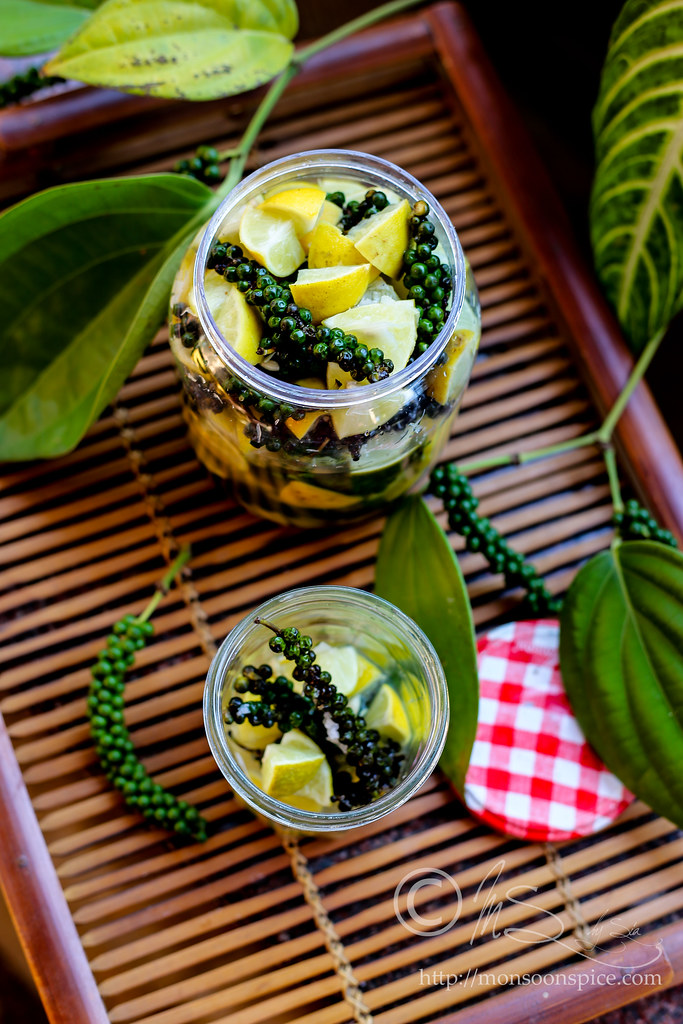
Learn how to make Lime and Fresh Green Peppercorn Pickle ~ Pickled Indian limes and fresh green peppercorns in brine
‘Sacred’ is a very special word that I use for pickles.
Pickles, a heart and soul of Indian cuisine is the most precious condiments without which our meals are unimaginable and well, incomplete. The word pickle is an emotion and it screams ‘home’. Whichever part of India and Indian subcontinents we might come from, a smudge of pickle on a plate has the capacity to make even the simple meal of dal and rice seem more appetising. For Indians,
pickles are not mere a condiment, but an integral part of the meal and a tasty accompaniment which keeps us connected to our roots even when we are thousands of miles away from our home and homeland.
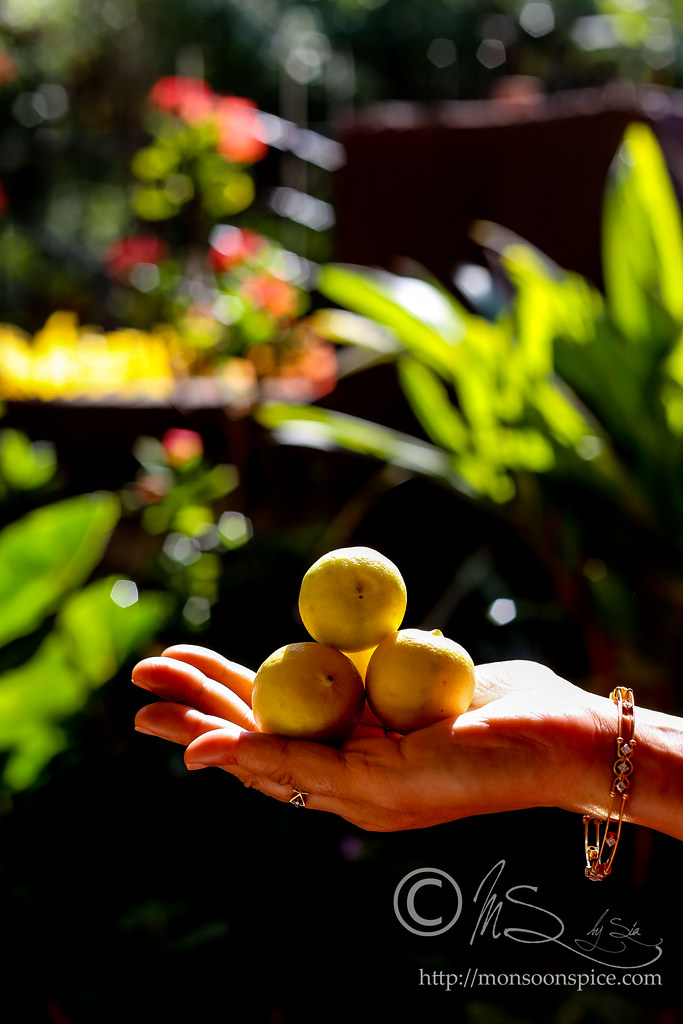
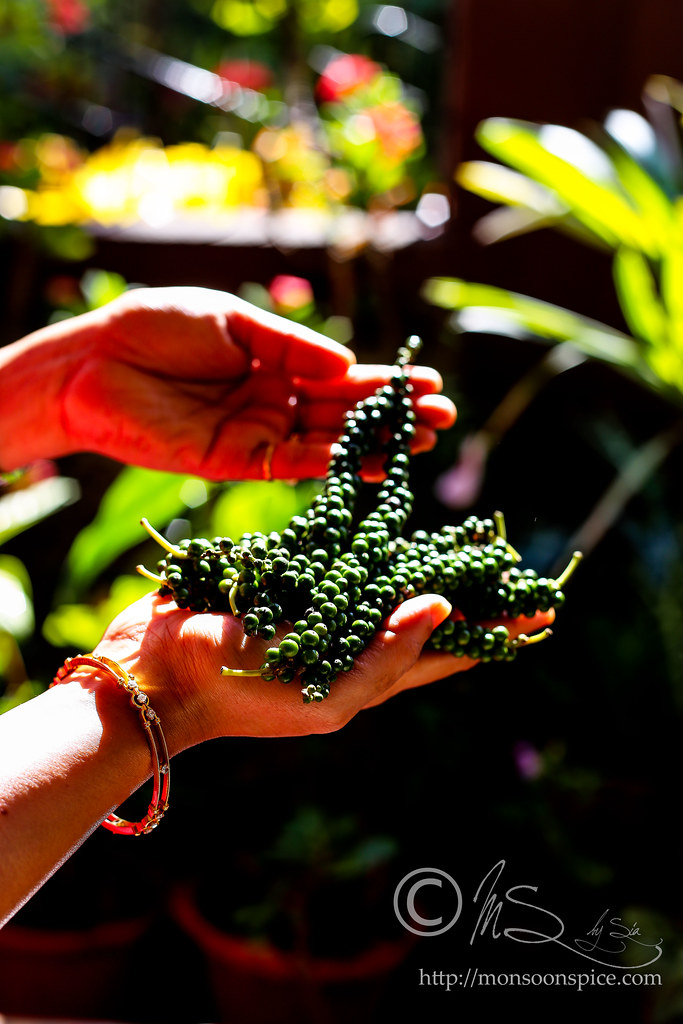
As a child, my first food memories revolves around pickle. Come summer and my ancestral home would transform into a buzzing pickle factory. Pickle making was a family effort and everyone in our large joint family had a role to play in this most exciting process. There were special mango trees cultivated in our family estate specially reserved for pickling. These pickling mangoes had right amount of acidity, texture and crunch for making the perfect and most delicious pickles. It was my grandfather’s role to make sure that the farm workers plucked the mangoes at the right time before they matured, taking care not to drop them on the grounds as they reduced the shelf life. Most mangoes were pickled before they developed hard stones and some were left on the trees to mature for other varieties of
mango pickles. As a child, I remember watching the workers expertly climb a century old mango trees and pick the mango bunches and carefully stock them in a wicker baskets hanging next to them in a long rope. Once the basket was filled to the brim, it was carefully lowered to the ground where it was emptied into huge wicker baskets lined with gunny bags. Thousands and thousands of tender mangoes were then carried back home where the ladies of the house eagerly waited.
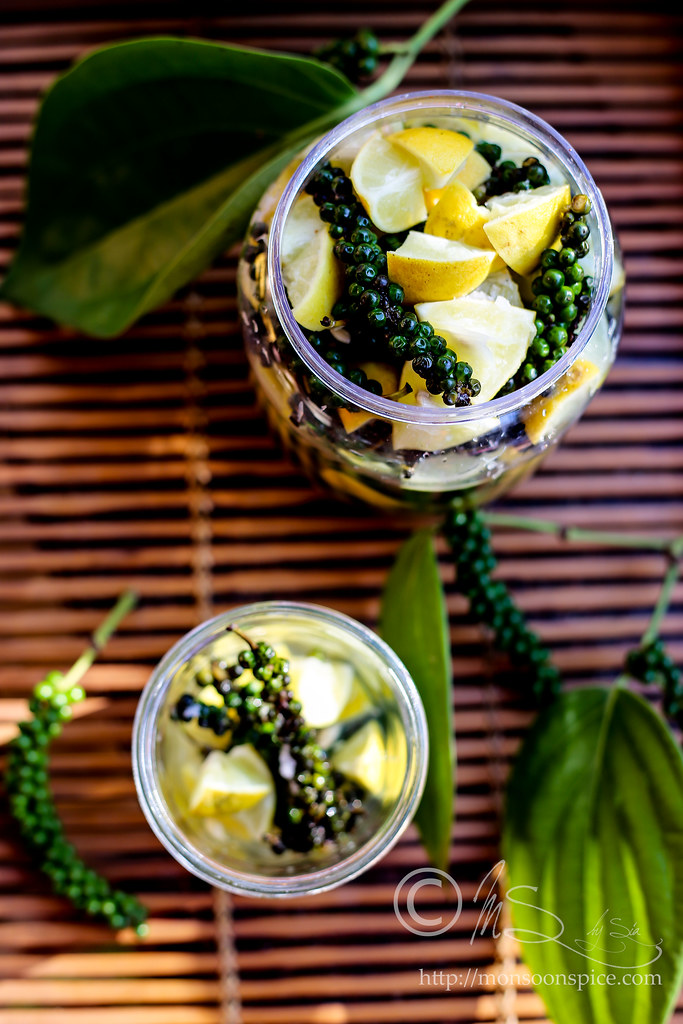
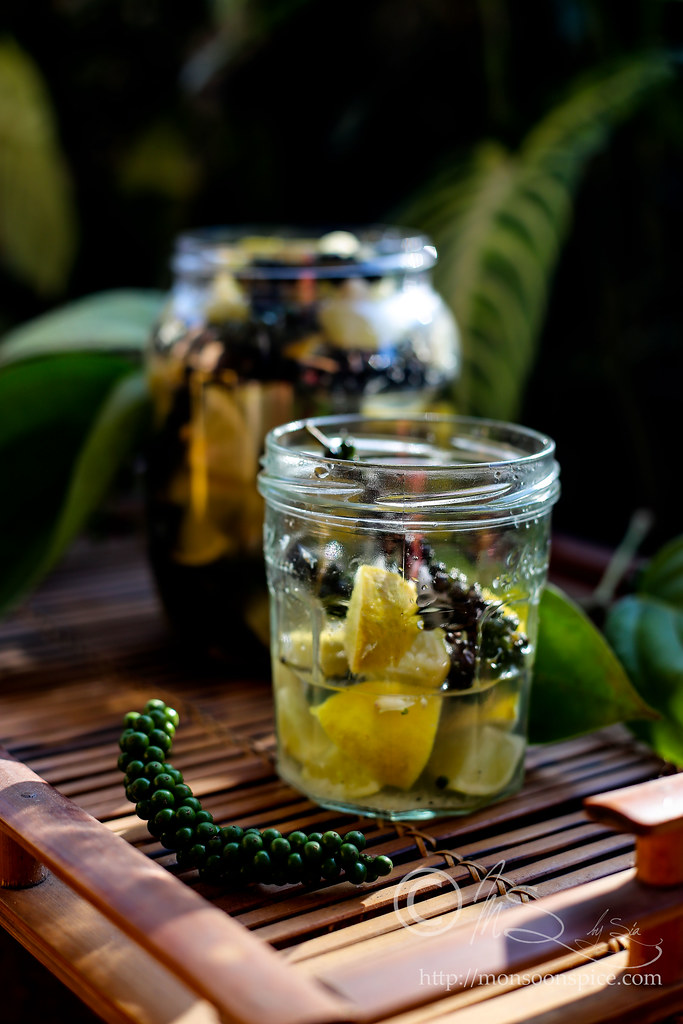
The central courtyard was the place where all the ladies of the family and sometimes, ladies from the extended family and neighbourhood gathered. Since most of the pickling was done during summer, all the married daughters of the family who came with their kids for extended summer holidays also joined the excitement. The whole atmosphere had the buzz of a great party where ladies were dressed in their old sarees instead of their fineries. :) My mom would find the old dress that no longer fitted as she was well aware of my love for mangoes and the stains that I always managed to paint on my cloths!
My grandma, a seasoned pickle maker, overlooked the whole process of pickling. This was a pickle making in bulk scale as tonnes of pickle were made for the family and extended family who lived away from home. The fresh batch of pickle would last until next summer and some for many years if they they miraculously survived the greedy taste buds! The experts were assigned to choose the mangoes for different pickles; the small tender raw mangoes with high acidity were chosen for the whole tender mango pickles and the larger ones would be used for different varieties of cut sweet and spicy mango pickles. The kids were in charge of counting the mangoes. The apprentice pickle makers were assigned the task of separating the mangoes from their stems and the rest of the women proceed to measure whole spices under the expert eye of masters in pickle making. Tonnes of whole spices; varieties of dry red chillies, mustard seeds, cumin seeds, fenugreek seeds and coriander seeds, spread on old cotton sarees in the courtyard and in the backyard which were sun dried under the hot summer sun were carefully measured and pounded in a large stone grinder, something similar to pestle and mortar, by hand to get the right consistency.
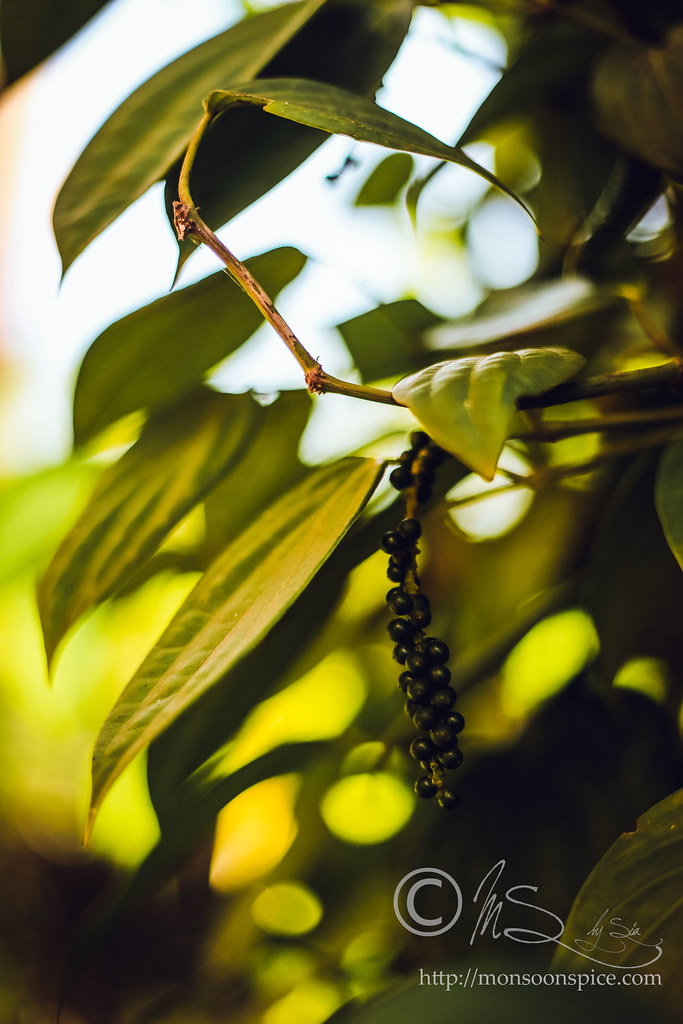
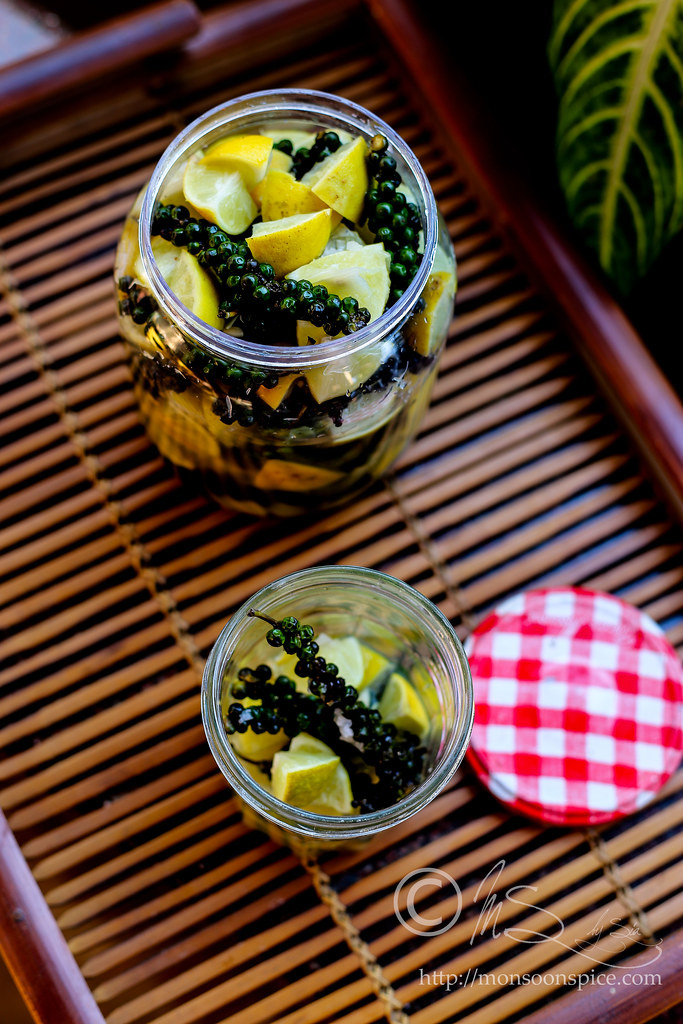
The whole mangoes were transferred into a large bharaNi, a ceramic jars, and tightly cramped in layers of sea salt covering every single layer of mangoes before tightly covering the mouth of the jar with muslin cloths and a lid. These jars were then kept in a dark attic above the kitchen where no sunlight touched them. They sat there for weeks, covered in layers of rock salt, until their emerald green skin changed to yellowish tinge and their smooth skin shrivelled, shrunk and wrinkled like a hand of an old lady! Similarly, some cut mango pieces were mixed with generous amount of sea salt before sealing their lid with a muslin cloth and putting it away in attic to mature while other mango pieces were cooked in a salted water to make different pickle.
With so many ladies working together invariably lead to long conversations. The gossips were hotter than the hottest red chillis which some women were pounding on a large stone, stories from the past more interesting than the mangoes, teasing sharper than the acidity of mangoes, friendship and love sweeter than the jaggary used in making sweet pickles. The conversations ranged from reflecting on the past and present and the discussions about what lied ahead for the family... It was not just about making pickles, but about making memories… It was not just about working together, but was a bonding experience! For the children of the house it was a time where we learned about our family trees, family values, the joy of working together, family traditions, food cultures, patience and a lesson on fine art of cooking!
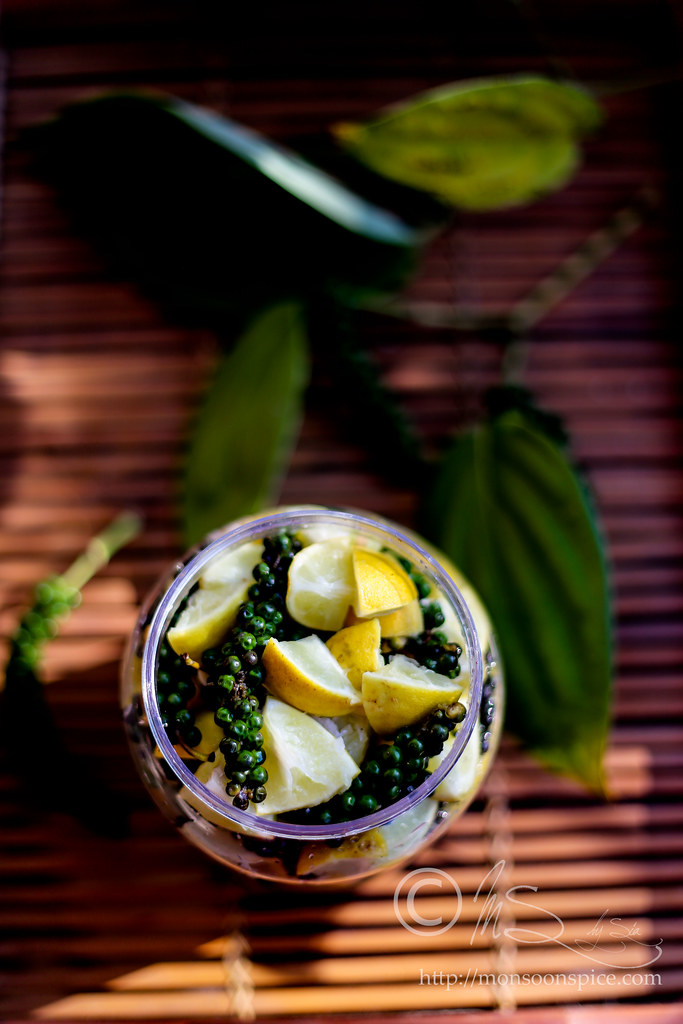
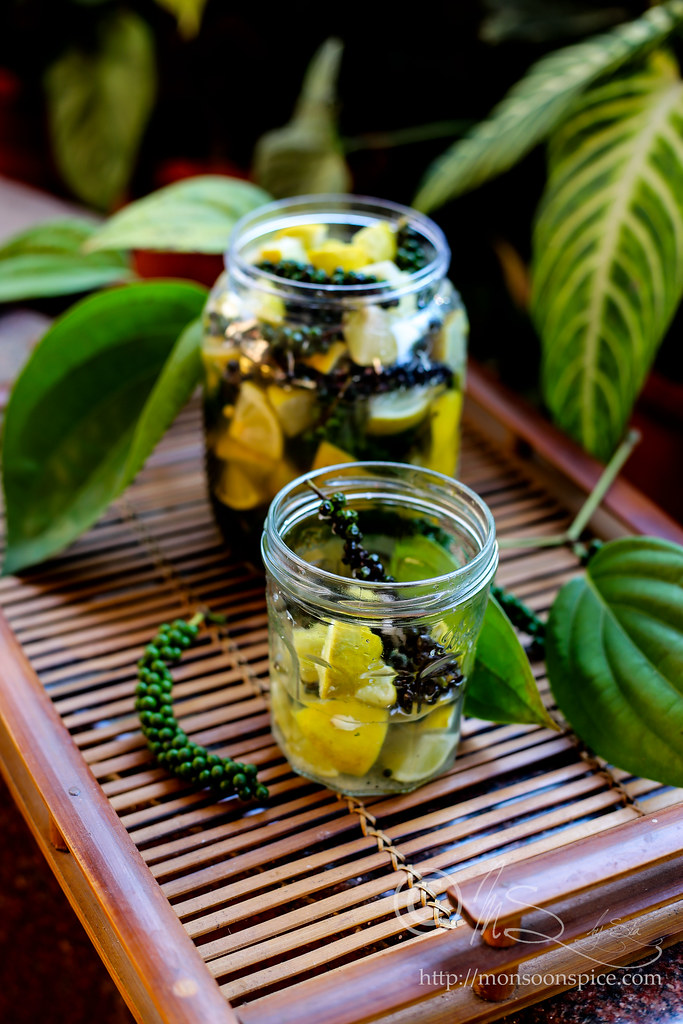
Sadly, this art of making pickle is slowly dying in the world where people shun anything that is time consuming and opt for convenience of ready to use. But with so much of our culinary history at stake, it is worth every penny to forsake the shortcut methods of store bought convenience for the time consuming and painstaking, yet most rewarding experience of making our own pickles at home. Truth to be told, there is no comparison between the much superior homemade pickle where best quality ingredients are used and carefully cooked to that of store bought pickle which is bulk produced in factories. Homemade pickle tastes different and oh so much better they bring the essence of the person who has made it. A pickle is a reflection of the person who has made it as it requires the knowledge, experience, best ingredients and patience. And trust me, no store bought, bulk produced, machine made pickle can compete with the taste of homemade pickle that dots on your dinner plate which enhances the taste of every morsel you take! Because in the end you are not just preserving the fruits or vegetables, but preserving memories, family recipes and the taste of home!
The most favourite pickle of mine is the mango pickle, but the pickle I am sharing today has no mango in it and it still tops the chart for its unique taste. This one is a Lime and Fresh Green Peppercorns Pickle where green peppercorn pods and lime wedges are preserved in a brine and lime juice mixture. The green peppercorns are milder and less pungent when compared to black peppercorns and are a wonderful ingredient for pickling. This December when I was in India, my mother bought a car boot full of green peppercorns from our farm to dry them. The sight fresh emerald green peppercorns tempted me to create one of my favourite pickles.
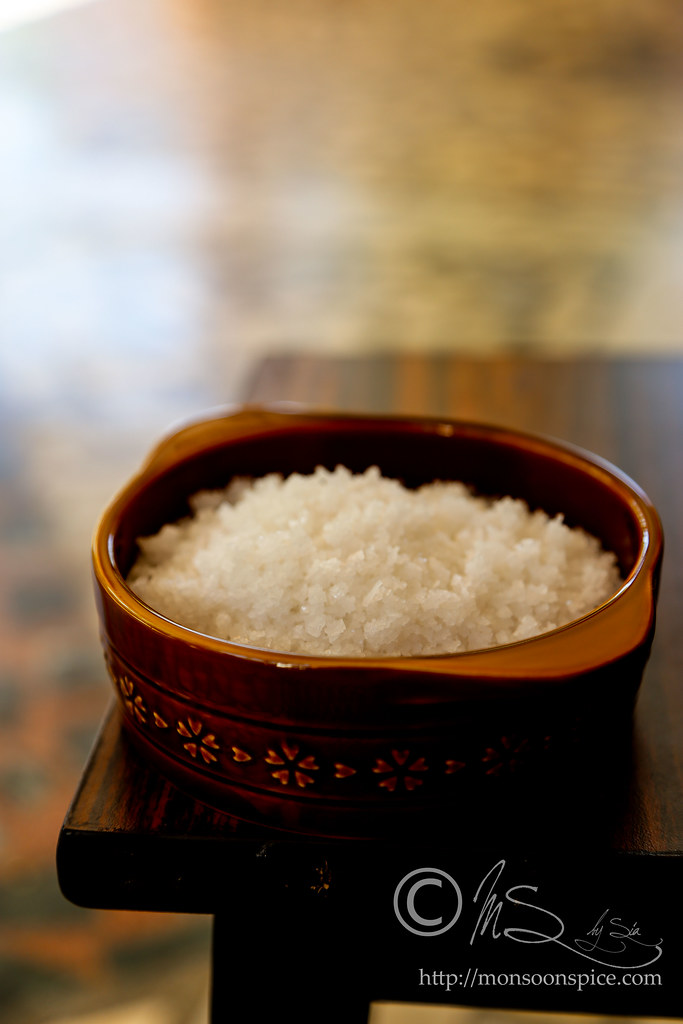
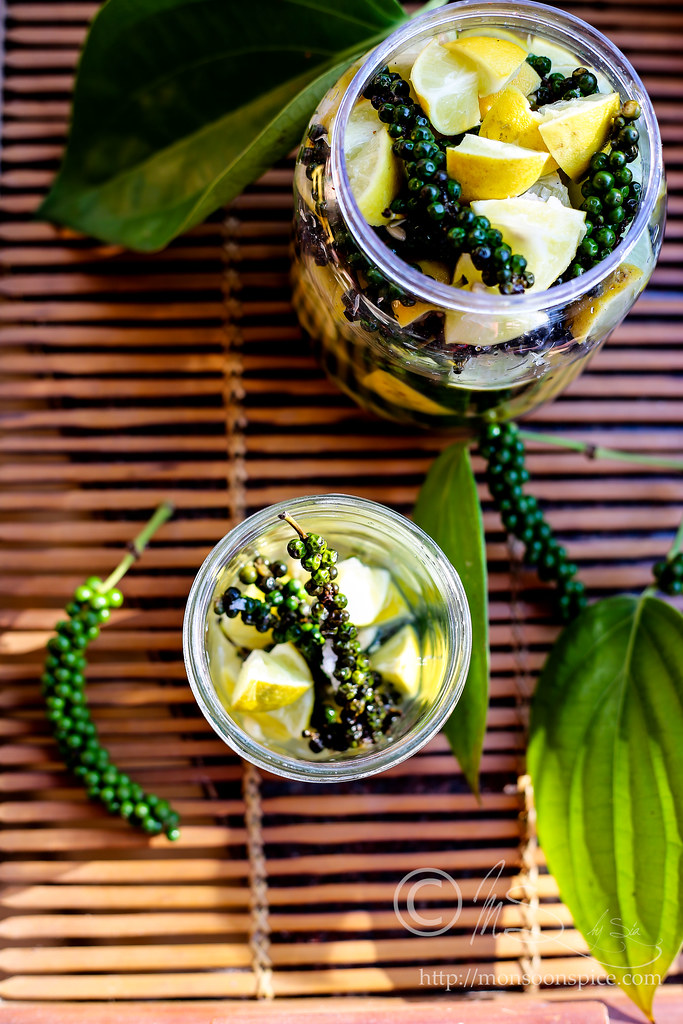
This Lime and Fresh Green Peppercorns Pickle is one of the easiest pickle recipe as it requires just 3 ingredients; lime, green peppercorns and salt. There are couple of things to take care of whenever you venture into making pickles. One, make sure that you use the peppercorns within a day of plucking them as they soon lose their freshness and green colour and turns black. The green peppercorns are not removed from the stalks and are pickled with their pods. Other thing to remember is to make sure all the utensils, spoons and ladles, knife and cutting board and storage jars are dry and moisture free as any moisture content will reduce the life of pickle. Also make sure that the limes and peppercorns are moisture free once they are rinsed and washed. I usually wash them a day before pickling (before going to bed) and spread them on a large kitchen towel to dry overnight. Alternately, you can dry them under a hot sun for not more than half an hour. Remember all these when making this pickle and you will have a jar full of one of the most delicious pickles to enjoy through the year!
I have used the small ping-pong sized Indian limes grown in my parents’ home. This lime has thin skin and is juicier and can be found in many ethnic stores in the UK. I have also seen some ethnic stores and Thai food specialty stores selling fresh green peppercorns in London at bit steep price. I have been lucky to get them from my parent’s garden where the peppercorn vines hug the coconut trees and also at my parents’ and in-law’s estate where they grow in abundant throughout the year. So if you find anyone selling or offering you some fresh green peppercorn pods, grab them with both hands and make this delicious Lime and Green Peppercorn Pickle.
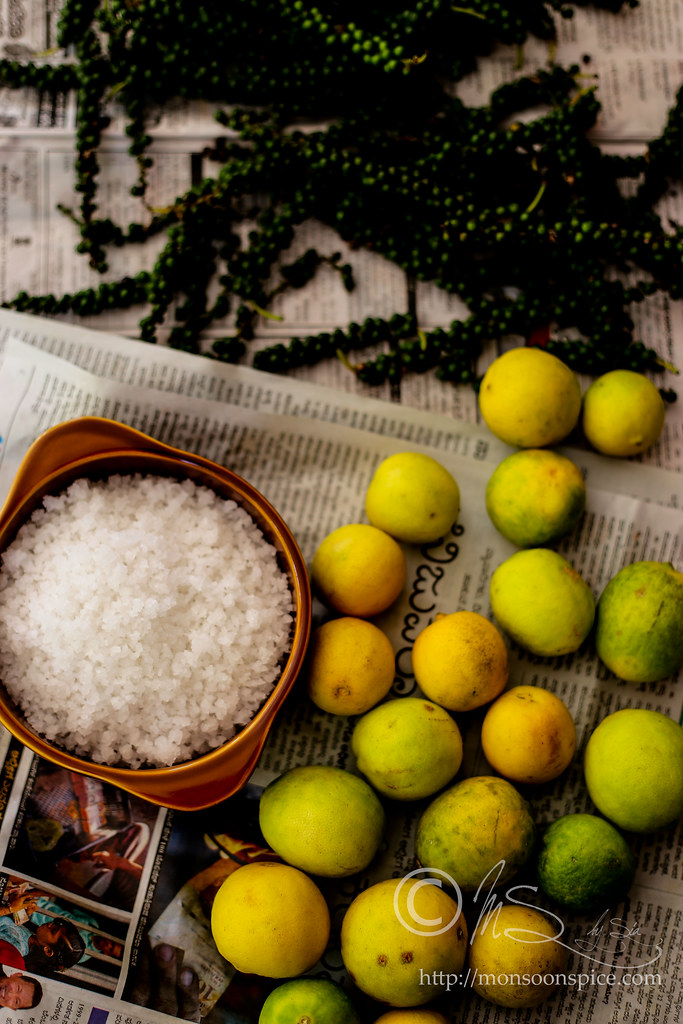
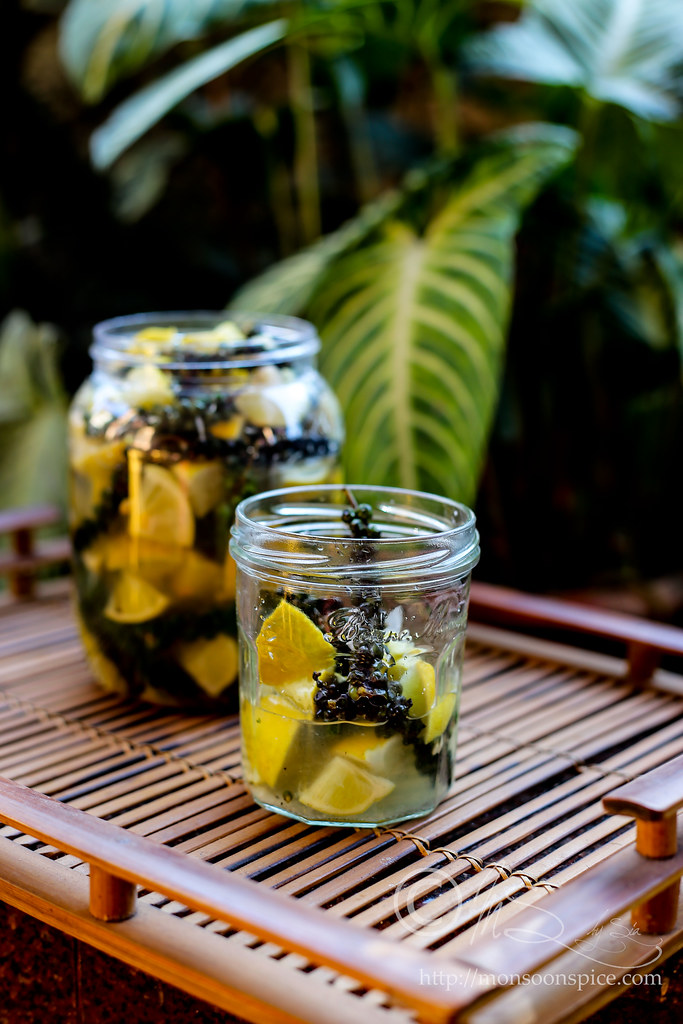
Indian Lime and Fresh Green Peppercorn Pickle (Pickled Indian limes and green peppercorns in brine)
Prep Time: 8-10 mins plus drying time
Cooking Time: 5 mins
Recipe Level: Easy/Beginner
Spice Level: Medium to High
Makes: About 1 litre jar
Shelf Life: Up to a year in cool and dry place
Serving Suggestion: With rice and yogurt or with
Mosaranna/Curd Rice
Ingredients:
15-18 Limes (I have used Indian Limes - Read notes)
15-20 Fresh Green Peppercorn Pods
½ cup + 1 tbsp Sea Salt/Rock Salt (Adjust as per taste)
¾ cup Water
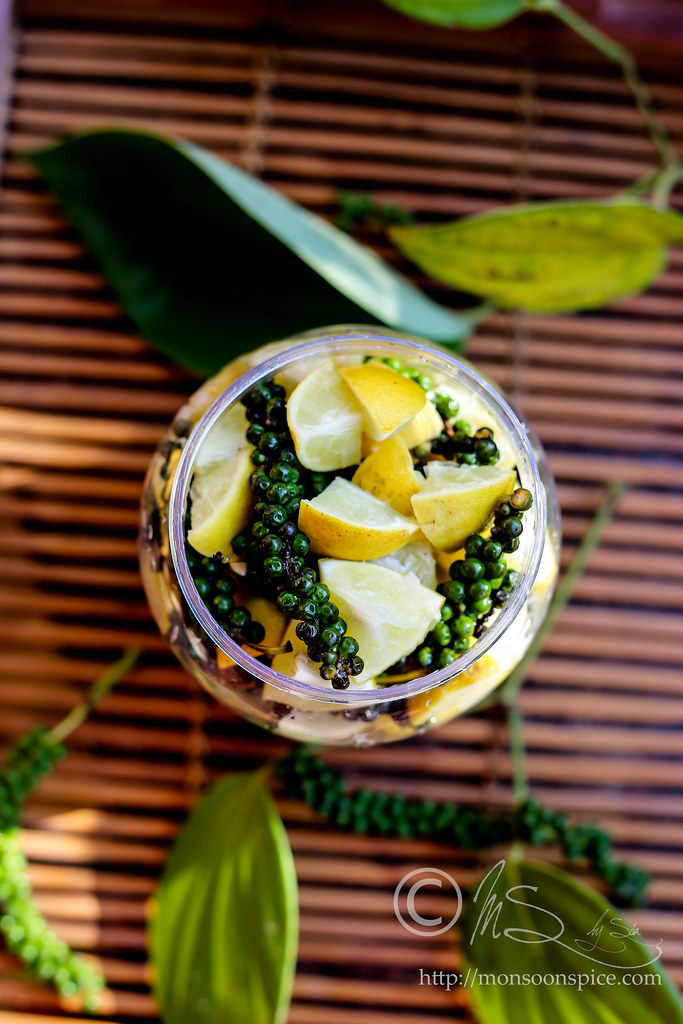
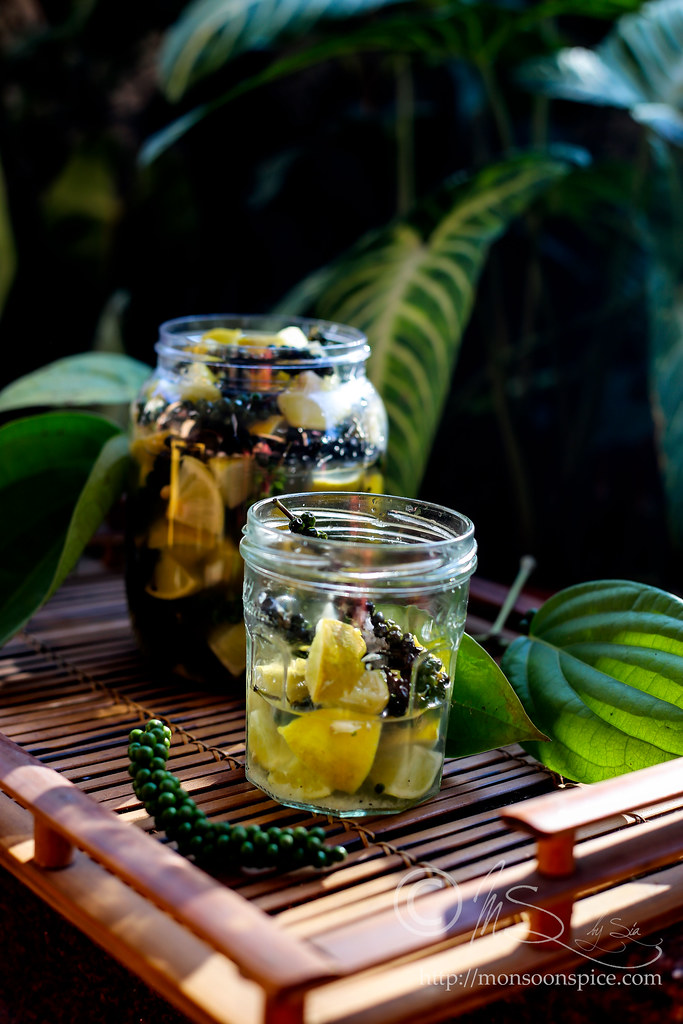 Method:
Method:
- Wash the limes thoroughly and wipe them dry with a kitchen towel. Spread them on a dry kitchen napkin and let them dry at least for 6 hours or preferably overnight.
- Rinse and wash the green peppercorn pods to remove any dirt and pat them dry with a kitchen towel. Spread them on a dry kitchen towel and let them dry least for 6 hours or preferably overnight. Alternately, you can dry them under a hot sun for not more than half an hour.
- Please make sure that both the limes and peppercorn pods are devoid of any moisture as it will reduce the shelf life of pickle.
- Bring water to a boil and add sea salt to it. Mix the salt and simmer it for a minute or two before turning off the flame. Let the water and salt mixture cool down to room temperature. Don’t worry if the salt doesn’t dissolve completely.
- Sterilise about 1 litre capacity glass jar with airtight lid and dry it in a sunlight until it is moisture free.
Proceed to make a pickle:
- Extract juice from 5-6 limes and keep it aside. Cut the remaining limes into halves and cut each halves into quarters.
- Take the lime pieces and green peppercorn pods in a large clean and dry mixing bowl. Add boiled and cooled salt water with any salt residue and lime juice and mix them well with a clean and dry spoon or ladle.
- Transfer the lime and peppercorn mixture with brine into the sterilised dry jar. Spread a tbsp. of sea salt on top and close the lid tightly. Keep it in a dark and cool place for about 2-3 weeks until the pickle matures. Make sure you open the lid and mix the pickle once in every 2-3 days using a clean and dry spoon.
- The pickle is ready to use when the lime and green peppercorns soften and changes colour to pale/dirty yellow. Serve this delicious Lime and Fresh Green Peppercorn Pickle with rice and yogurt or Mosaranna/Curd Rice and enjoy!
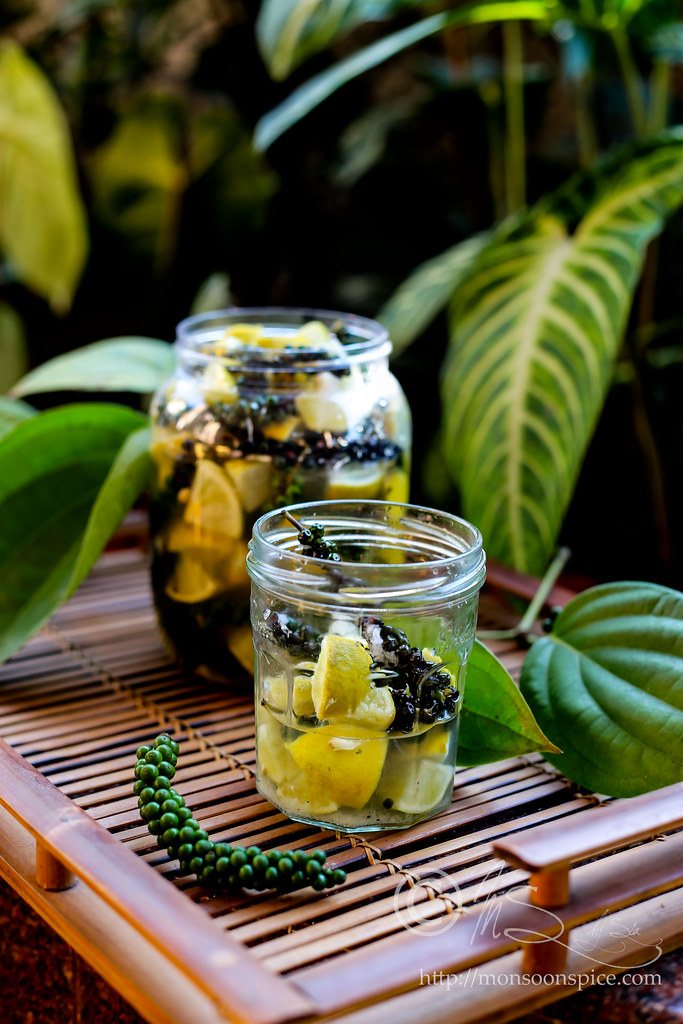
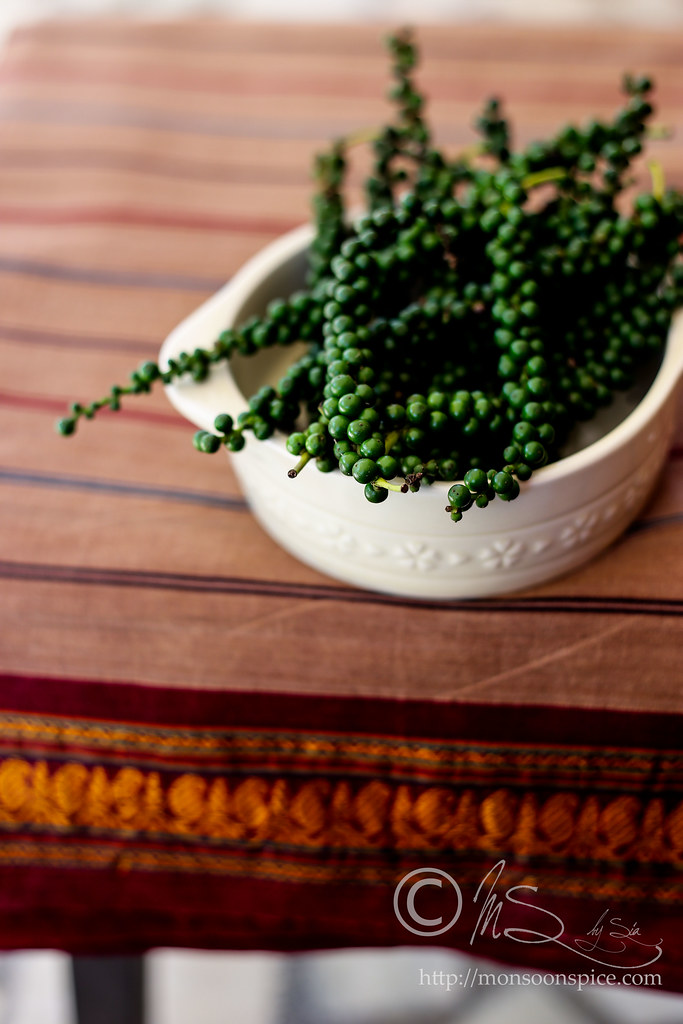
Sia's Notes:
- Please make sure all the utensils, spoons and ladles, knife and cutting board and storage jars are dry and moisture free as any moisture content will reduce the life of pickle.
- Similarly, make sure that the limes and peppercorns are moisture free once they are rinsed and washed. I usually wash them a day before pickling and spread them on a large kitchen towel to dry overnight. Alternately, you can dry them under a hot sun for not more than half an hour.
- I have used the Indian Limes which are ping-pong ball sized juicy limes with thin skins. These limes are sold in Indian/Ethnic stores in the UK and are quite juicer than the ones available in most supermarkets.
- This pickle will can be used for up to a year if made rightly. Make sure you store it in a cool and dry place. The peppercorn stalks will change to somewhat greenish-yellow colour when it matures in the lime and brine mixture. This, however, doesn’t affect the quality of the pickle and is edible.


















Totally agree with you on the taste and quality level of homemade pickles Sia. This post is bringing back lots of good memories.
ReplyDeleteAs always lovely pictures, one day will give a try :)
Thank you, Shilpa! It's only in the last decade I have truly began to appreciate the heirloom recipes and preserving the rich food culture. There is so much history, scientific reasons, and amazing stories behind these recipes and it would be crime not to share them :)
DeleteWow your photos are so beautiful! I've never had pickled limes before but this sounds gorgeous it would also make a great foodie gift!
ReplyDeleteThank you, Emily! Handmade and personalised food gifts are always something I love to give and receive :)
DeleteThis was such a joy to read! You're absolutely right that the art of pickling is being lost to modern convenience. Growing up, I had no clue how to pickle, and even today I'm most comfortable making "quick pickles" (veggies soaked in vinegar), because it's only recently that I've started to learn and appreciate the art of fermenting foods with salt. Hearing your story of growing up making mango pickles was truly a glimpse into another world for me, and an inspiring one. I've never even tasted lime pickles, but I will be keeping my eye out for those fresh green peppercorns from now on. Thank you for sharing your story and this recipe!
ReplyDeleteThank you, Willow for such kind words. The food blogs and food bloggers have helped me in getting to know different food cultures and heirloom recipes with their amazing stories and recipes. It's such a wonderful way to learn about different regional cuisines and their food histories. I love telling stories about the food I grew up watching my grandma/mom/aunts/uncles cook. So glad to hear that you found it inspiring. You made me smile and thank you for that :)
DeleteWow, I love how you share your history of "sacred" pickling. Your photos are gorgeous and I can feel your passion through your story. I have never made pickles but you make it look like something I could handle. Thanks for sharing!
ReplyDeleteThanks a lot, Karen. I know exactly what you mean as I too was scared of making pickles as it requires expertise and a lot of patience which I lack :) But trust me, this one is really simple recipe and the outcome is worth all the trouble :)
DeleteHow gorgeous these photos look- the flavors also sound really fantastic! For some reason this makes me long for summer!
ReplyDeleteThank you, Jessy. Limes and lemons always sing summer to me as well :)
DeleteThis was such a lovely post, and your photos are gorgeous. I've never done any pickling, but I absolutely want to give it a try now!
ReplyDeleteThank you, Tracy! Please do give it a try as it's as simple as it gets :)
DeleteI'm looking for fresh green pepper in Mumbai if anybody knows in which vegetable market it is available. Please do let me know.Would love to try this recipe Thanks for sharing.
ReplyDeleteI'm looking for fresh green peppercorns in Mumbai if anybody knows which local market has it.Please do let me know would like to try this recipe. THanks for sharing.
ReplyDelete